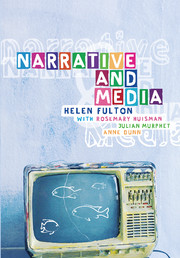Book contents
- Frontmatter
- Contents
- Figures and tables
- Contributors
- Acknowledgements
- 1 Introduction: the power of narrative
- Part 1 The basics of narrative theory
- Part 2 Film as narrative and visual mode
- Part 3 Television: narratives and ideology
- Part 4 Radio and print journalism
- Part 5 Popular print culture
- 18 Magazine genres
- 19 Advertising narratives
- 20 Conclusion: postmodern narrative and media
- Glossary
- Bibliography
- Index
20 - Conclusion: postmodern narrative and media
Published online by Cambridge University Press: 05 June 2012
- Frontmatter
- Contents
- Figures and tables
- Contributors
- Acknowledgements
- 1 Introduction: the power of narrative
- Part 1 The basics of narrative theory
- Part 2 Film as narrative and visual mode
- Part 3 Television: narratives and ideology
- Part 4 Radio and print journalism
- Part 5 Popular print culture
- 18 Magazine genres
- 19 Advertising narratives
- 20 Conclusion: postmodern narrative and media
- Glossary
- Bibliography
- Index
Summary
At the beginning of Tom Tykwer's film Run, Lola, Run (1999), the voice-over says: ‘Countless questions in search of an answer … an answer that will give rise to a new question, and the next question will give rise to a second question, and so on.’
This announcement calls attention to the instability of meaning, which is a central concept of post-structuralist theory and lies at the heart of postmodern representation. The content and structure of the film challenge the conventions of causality, temporality, motivation and closure that characterise realist narrative and offer instead something closer to a postmodern narrative based on uncertainty, repetition with variation, multimodalism and a constant disruption of the movement from signifier to signified that stabilises meaning. Yet the idea of a ‘postmodern narrative’ appears to be something of an oxymoron, since postmodernism explicitly rejects totalising narratives with their neat explanations and carefully signposted points of closure. Is such a concept possible?
There is no doubt that contemporary media texts, and their narrative modes, continue to locate themselves comfortably in the aesthetic of classic realism. Emerging at the same time as the rise of industrial capitalism, in the late nineteenth century, the mode of realism enacts a specific ideological agenda, ‘not only in its representation of a world of consistent subjects who are the origin of meaning, knowledge and action, but also in offering the reader, as the position from which the text is most readily intelligible, the position of subject as the origin both of understanding and of action in accordance with that understanding’ (Belsey 1980: 67).
- Type
- Chapter
- Information
- Narrative and Media , pp. 300 - 306Publisher: Cambridge University PressPrint publication year: 2005



